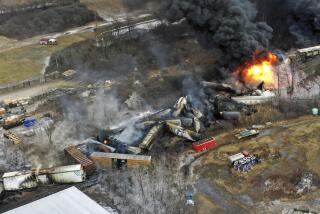Tire Recall Has Brought Many Changes in the Name of Safety
- Share via
The Firestone tire recall that began a year ago today probably will be seen by future generations as a turning point in American automobile safety regulation.
In a few years, new passenger vehicles will come equipped with tire pressure monitoring devices; new tests probably will be used to predict whether a car or truck will roll over in a crash; a 30-year-old crush-resistance standard for automobile roofs will have been updated; and the manufacturers of automobiles and auto equipment such as tires and brakes will be giving government safety agencies more product defect data, more quickly than ever.
All that has been mandated by the government in the last year as a result of the Firestone tire recall.
But for the millions of motorists battling for survival on today’s highways in today’s cars and trucks, most meaningful changes are still a year or more away.
“There’s been good progress, but not enough,” said Deputy Transportation Secretary Michael Jackson.
“It is so difficult to say how far we have come because so much is still pending,” said Stephen Oesch, senior vice president of the Insurance Institute for Highway Safety. Movement has started toward improving the automotive safety environment, he said, “but we still have a way to go before we see what the proposals for regulation are and what their potential effects will be.”
One measurable effect is that Congress last year added $9 million to the National Highway Traffic Safety Administration’s budget--a budget that was slashed during the Reagan administration and has never recovered.
Some of the extra funding was for hiring 30 new people--20 are on board already--many of them in the defect investigation and research department. Other funds are earmarked for improving the agency’s antiquated computer system and for some of the new testing required by Congress in the Transportation Recall Enhancement Accountability and Documentation Act that was passed in October and signed into law by outgoing President Clinton.
NHTSA is seeking an additional budget boost for 2002--to $419 million from this year’s $403 million. A spokesman for House Energy and Commerce Committee Chairman W.J. (Billy) Tauzin (R-La.) said Wednesday that despite its frequent criticisms of the agency, the committee “will continue to assist NHTSA in its efforts to secure additional funds.”
That’s a big plus, says Sean Kane of Strategic Safety, a Virginia-based consumer advocacy firm. “We can look back at Firestone and say that under a conservative administration we probably won’t lose any ground and may even move ahead a little.”
Another direct result of the tire debacle is a move toward greater public access to product liability lawsuits. In California, for example, legislators passed a law that took effect in January making it more difficult for lawyers in such cases to seal the court transcripts and documents. Safety groups had argued that sealed cases kept the public from learning about tire defects for years.
But the most important legacy of the Firestone debacle, safety advocates and industry insiders say, is that consumers are much more aware of the rubber that separates their vehicles from the roads, and of the physics that make sport-utility vehicles more likely than other vehicles to roll over in a collision or catastrophic tire failure.
“People are paying a lot more attention to their tires,” said Rob Strassburger, vice president for vehicle safety at the Alliance of Automobile Manufacturers. “They do understand that proper inflation is important, and that they should take care not to overload the vehicle.”
Although many of the federal rules don’t kick in for a year or more, the safety landscape today is far different than it was Aug. 9, 2000.
That’s the day tire maker Bridgestone/Firestone Inc. reluctantly announced a voluntary recall of some 6.5 million Firestone-brand Wilderness, ATX and ATX II tires that were supplied as original equipment on the Ford Explorer--the nation’s best-selling SUV--as well as on a small number of other trucks and SUVs from Ford and other auto makers.
The recall came amid growing concern that something was drastically wrong, but it was quickly apparent that NHTSA--the nation’s first-line defense against automotive safety defects--had few clues.
Neither Ford nor Firestone was required to report the hundreds of warranty claims and complaints they had received concerning the problem tires. And Ford, which had voluntarily recalled similar tires on SUVs sold in Venezuela and the Persian Gulf, had not reported those recalls because there was no legal requirement to do so.
At first, both Firestone and Ford denied a problem existed in the U.S.; then each blamed the other. And as they squabbled, evidence mounted that the tires, maybe on their own, maybe helped by a design flaw in the Explorer, were tearing apart with unsettling regularity.
A year ago, when the recall began, some 300 crashes and 46 deaths were being blamed on accidents that occurred when Firestone tires lost their tread and the vehicles they supported lost their grip on the road. Today the toll is 203 deaths and more than 700 injuries, and climbing.
The crisis has transcended Firestone, although that name forever will be linked in the public mind to terms like “tire failure” and “tread separation.” Late last year, Continental-General recalled 160,000 tires used on Ford and Lincoln SUVs. Product liability attorneys and safety advocates are urging NHTSA to investigate the safety record of Goodyear Tire & Rubber Co.’s light truck tires as well.
Ford has turned up the heat in a public relations war with Bridgestone/Firestone and launched the voluntary recall of 13 million more Firestone tires used on various Ford vehicles--at an estimated cost to Ford of $21 million.
Firestone has retaliated by trashing the Explorer, claiming the design of those built before the 2001 model year is inherently flawed and that crashes and rollovers of Firestone-clad Explorers should be blamed on the vehicle, not the tire. The fight resulted in the severance this year of Ford’s 95-year preferred-supplier relationship with Firestone.
The incessant battling has done little to hurry a solution and a lot to confuse consumers. Explorer sales are down, although the SUV remains the most popular vehicle in that category.
But some good is coming from the debacle; the main players are changing the way they do business.
Ford is overhauling the way it monitors tire performance on its vehicles and is collecting more data from tire suppliers. It now warranties tires that come with its vehicles instead of forcing the consumer to deal separately with the tire company, a path General Motors Corp. chose for itself several years ago.
Bridgestone/Firestone has shaken up its management, promoting an American, John Lampe, to chief executive of the Nashville-based subsidiary of Japan’s Bridgestone Corp. Lampe has established a Quality Assurance Committee to function as an internal early-warning system to identify issues before they become a problem.
Bridgestone itself replaced its president earlier this year with an executive with a technical rather than a financial background. “That sent a message that there will be tremendous focus on manufacturing,” said Bridgestone/Firestone Executive Vice President Mark Emkes.
Firestone also is closing its plant in Decatur, Ill., where many--though not most--of the bad tires were made and suspended a controversial manufacturing process that allowed over-aged rubber to be used in its tires.
Most important, “we’re asking a heck of a lot more questions,” Emkes said. “How will the tires be used, and on what vehicles? Will it be on- or off-road? what tire pressure do [the auto makers] anticipate recommending?”
That’s going to be critical going forward. In fact, sharing information, no matter how reluctantly, is a key element of the TREAD Act.
“It will be a massive change because if the agency gets data early it will be able to make calls about safety and not just wait until the manufacturers decide it is time,” said Joan Claybrook, a former NHTSA administrator who now heads Public Citizen, a Washington-based consumer advocacy group.
One legacy of the tire debacle that won’t go away soon is the hundreds of lawsuits filed against Ford and Firestone. Some have been settled with multimillion dollar payments, but most remain unsettled.
On Monday, Bridgestone/Firestone lost a bid to delay a trial in the case of a woman who says she suffered brain injuries after a tire failed and her Ford Explorer rolled over.
The protracted litigation is likely to cast its shadow over both Ford and Firestone--and keep auto safety issues in the public eye for years to come.
*
O’Dell reported from Los Angeles and Jones from Detroit.
(BEGIN TEXT OF INFOBOX / INFOGRAPHIC)
Tougher Safety Standards
The Firestone tire recall that began a year ago set into motion sweeping changes in the automotive safety environment, many included in the federal Transportation Recall Enhancement Accountability and Documentation Act, also known
as TREAD. Key provisions:
* Adds $9 million in funding to the National Highway Traffic Safety Administration’s budget.
* Beefs up penalties for auto companies that fail to report defect information promptly. The maximum fine per incident increases to $15 million from $1 million.
* Gives NHTSA authority to require auto makers to install a tire pressure monitoring system as standard equipment, starting with 2004 models. The rules are being drafted.
* Requires NHTSA by June 2002 to upgrade federal tire safety standards and develop rules for early reporting by auto and auto- parts makers of product defect claims and deaths and injuries lamed on product defects.
* Requires NHTSA by November 2002 to develop a dynamic test for determining a vehicle’s propensity to roll over in accidents or under panic steering.
* Requires NHTSA by November 2002 to devise a child safety seat rating system and tougher standards for child safety seats.
* Gives NHTSA authority to require auto and auto-parts makers to report safety recalls conducted in foreign countries.






